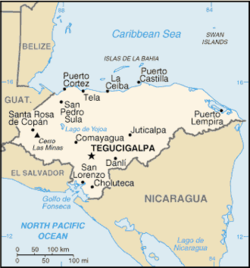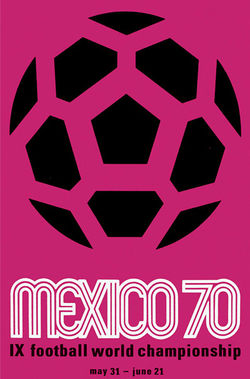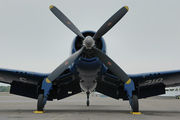Football War
| Football War | |||||||
|---|---|---|---|---|---|---|---|
 Map of Honduras, where most of the fighting took place |
|||||||
|
|||||||
| Belligerents | |||||||
| Strength | |||||||
| 30,000 (Army) 1,000 (Air Force) |
23,000 (Army) 600 (Air Force) |
||||||
| Casualties and losses | |||||||
| 900 (including civilians) | 2,100 (including civilians) | ||||||
The Football War (La guerra del fútbol, in Spanish), also known as the Soccer War or 100-hours War, was a four-day war fought by El Salvador and Honduras in 1969. It was caused by political conflicts between Hondurans and Salvadorans, namely issues concerning immigration from El Salvador to Honduras. These existing tensions between the two countries coincided with the inflamed rioting during the second North American qualifying round for the 1970 FIFA World Cup. On 14 July 1969, the Salvadoran army launched an attack against Honduras. The Organization of American States negotiated a cease-fire which took effect on 20 July, with the Salvadoran troops withdrawn in early August.
Eleven years later the two nations signed a peace treaty on 30 October 1980 [1] to put the border dispute over the Gulf of Fonseca and five sections of land boundary before the International Court of Justice. In 1992, the Court awarded most of the disputed territory to Honduras, and in 1998, Honduras and El Salvador signed a border demarcation treaty to implement the terms of the ICJ decree. The total land area given to Honduras from El Salvador after the court's ruling was around 374.5 km2. As of the beginning of 2006 demarcation had not yet been completed, but Honduras and El Salvador maintain normal diplomatic and trade relations.[2]
Contents |
Context
Although the nickname "Football War" implies that the conflict was due to a football game, the causes of the war go deeper. The roots of the war were issues over land reform in Honduras and immigration and demographic problems in El Salvador. Honduras is more than five times the size of neighbouring El Salvador, even though in 1969, El Salvador had a population that was more than double that of Honduras. At the beginning of the twentieth century, Salvadorans had begun migrating to Honduras in large numbers. By 1969, more than 300,000 Salvadorans were living in Honduras. These Salvadorans made up twenty percent of the peasant population of Honduras.[3] In Honduras, as in much of Central America, a large majority of the land was owned by large landowners or big corporations. The United Fruit Company owned ten percent of the land, making it hard for the average landowners to compete. In 1966, the United Fruit Company banded together with many other large companies to create la Federación Nacional de Agricultores y Ganaderos de Honduras (FENAGH; the National Federation of Farmers and Livestock-Farmers of Honduras). FENAGH was anti-campesino as well as anti-Salvadoran. This group put pressure on the Honduran president, General Lopez Arellano, to protect the property rights of wealthy landowners.[4]
In 1962, Honduras successfully enacted a new land reform law.[5] Fully enforced by 1967, this law gave central government and municipal land much occupied illegally by Salvadoran immigrants and redistributed this land to native-born Honduran peoples as specified by the Land Reform Law. The land was taken from both immigrant farmers and squatters regardless of their right to ownership and the status of their immigration. Thousands of Salvadorans were displaced by this law and were forced to emigrate once again. Salvadoran newspapers then heightened the already stressed relationship between the two countries by showing the many supposed atrocities being committed against Salvadorans in Honduras.
Thousands of Salvadoran labourers were expelled from Honduras, including both temporary harvest workers and longer-term settlers. This general rise in tensions ultimately led to a military conflict.
War
Buildup

Honduras and El Salvador met in the second North American qualifying round for the 1970 FIFA World Cup. There was fighting between fans at the first game in the Honduran capital of Tegucigalpa on 8 June 1969, which Honduras won 1 - 0. The second game, on 15 June 1969 in the Salvadoran capital of San Salvador, which was won 3 - 0 by El Salvador, was followed by even greater violence.[6] A play-off match took place in Mexico City on 26 June 1969. El Salvador won 3 - 2 after extra time.
On the same day, 26 June 1969, El Salvador dissolved all ties with Honduras, stating that "the government of Honduras has not taken any effective measures to punish these crimes which constitute genocide, nor has it given assurances of indemnification or reparations for the damages caused to Salvadorans".[7] This led to border clashes between the two nations.
First shots
Late in the afternoon of 14 July 1969, concerted military action began. The Salvadoran Air Force (El Salvador lacked sufficient military air equipment, resorting to the use of passenger airplanes with attached vessels strapped to their sides as bombers) attacked targets inside Honduras, including the airport facility at Toncontin and other strategic places, leaving the Honduran air force almost unable to react after dropping more than 22 100-pound bombs. The Salvadoran army launched major offensives along the two main roads connecting the two nations. At first, the Salvadorans made fairly rapid progress. By the evening of 15 July, the Salvadoran army, which was considerably larger and better equipped than its Honduran opponent, had advanced into Honduras and taken the departmental capital of Nueva Ocotepeque and eight other cities. Thereafter, the attack bogged down, the Salvadorans' pace slowing. The Honduran air force's reaction included bombing the Ilopango military airport facility with four planes, but the Salvadoran military was ready and repelled the attack. Three Honduran bombs were dropped, with only one exploding and missing the targeted airport facility. The same planes also bombed an oil facility. This was the only Honduran incursion into Salvadoran soil. The Honduran bombing included the use of napalm, while the Salvadorans did not use napalm in their bombings in Honduras.
When things became desperate for the Salvadoran Air Force , a number of well-known American pilots with current experience on the P-51 Mustang were retained, including Chuck Lyford, Bob Love, Lynn Garrison, and Ben Hall. Their missions against the Honduran Vought F4U Corsairs marked the world's last combat between propeller driven aircraft.
During the war, the Third Military Zone of the Honduran Army was discovered to have only half of its allotted soldiers. The money for the missing troops had been collected by an apparently corrupt Honduran Army officer. Nicaraguan dictator Anastasio Somoza Debayle helped Honduras by providing weapons and ammunition.
Cease fire
The day after the fighting had begun, the OAS met in an urgent session and called for an immediate cease-fire and a withdrawal of El Salvador's forces from Honduras. El Salvador resisted the pressures from the OAS for several days, demanding that Honduras first agree to pay reparations for the attacks on Salvadoran citizens and guarantee the safety of those Salvadorans remaining in Honduras. A cease-fire was arranged on the night of 18 July; it took full effect only on 20 July. El Salvador continued until 29 July to resist pressures to withdraw its troops. Then a combination of pressures led El Salvador to agree to a withdrawal in the first days of August. Those persuasive pressures included the possibility of OAS economic sanctions against El Salvador and the dispatch of OAS observers to Honduras to oversee the security of Salvadorans remaining in that country. The actual war had lasted just over four days, but it would take more than a decade to arrive at a final peace settlement.
Withdrawal

El Salvador, which had refused to withdraw its troops from the occupied territory in Honduras, finally withdrew its troops on 2 August 1969. On that date, Honduras guaranteed Salvadoran President Fidel Sanchez Hernandez that the Honduran government would provide adequate safety for the Salvadorans still living in Honduras. He had also asked that reparations be paid to the Salvadoran citizens as well, but was never accepted by Hondurans. There were also heavy pressures from the OAS and the debilitating repercussions that would take place if El Salvador continued to resist a withdraw of their troops from Honduras.
The war is often cited as the last occasion on which piston-engined fighters fought each other, both sides deploying former World War II and Korean War American aircraft. Cavalier F-51D Mustangs, F4U-1, -4 and -5 Corsairs, T-28A Trojans, AT-6C Texans and even C-47 Skytrains converted into bombers saw action.
Consequences
In the end, both sides of the Football War suffered extensive casualties. Some 300,000 Salvadorans were displaced due to the battle. Many had been forcibly exiled or had fled from war-torn Honduras, only to enter a Salvador in which the government was not welcoming. Most of these refugees were forced to provide for themselves with very little assistance. Over the next few years, more Salvadorans returned to their native land, where they were surrounded by overpopulation and extreme poverty.[8]
El Salvador suffered about 900 troops and civilians killed during the war. This was the first time that the military of El Salvador had ever seen combat.
Honduras lost 100 combat troops, and over 2,000 civilians were killed during the four days, since most of the war was fought on Honduran soil. Thousands more had been ultimately made homeless. Trade between Honduras and El Salvador had been greatly disrupted, and the international border had been officially closed. This damaged the economies of these nations tremendously and threatened the Central American Common Market (CACM).
- The war led to a 22-year suspension of the Central American Common Market, a regional integration project that had been set up by the United States largely as a means of counteracting the effects of the Cuban Revolution.
- The political power of the military in both countries was reinforced. In the Salvadoran legislative elections that followed, candidates of the governing National Conciliation Party (Partido de Conciliación Nacional, PCN), were largely drawn from the ranks of the military. Having apologised for their role in the conflict, they proved very successful in elections both at the national and local levels. However, these elections were considered fraudulent, especially on the part of the military dictatorship that virtually ruled El Salvador.
- The social situation in El Salvador worsened, as the government proved unable to satisfy the economic needs of its citizens deported from Honduras. The resulting social unrest was one of the causes of the El Salvador Civil War, which followed ten years later.
See also
- Sports and politics
References
- ↑ http://content.glin.gov/summary/13963
- ↑ "Background Note: Honduras". U.S. State Department. http://www.state.gov/r/pa/ei/bgn/1922.htm. Retrieved 23 November 2009.
- ↑ Acker, Allison. Honduras: The Making of a Banana Republic. Toronto: Between the Lines, 1988.
- ↑ Anderson, Thomas P. The War of the Dispossessed: Honduras and El Salvador 1969. p.64-75 Lincoln: University of Nebraska Press, 1981.
- ↑ http://content.glin.gov/summary/155709
- ↑ Goldstein, Erik (1992). Wars and Peace Treaties, 1816-1991. Routledge. pp. 195-6. ISBN 9780203976821. http://books.google.ie/books?id=VjWnMm53xQ8C&pg=PA195&dq=football+war+honduras+el+salvador&hl=en&ei=8YcwTLPuEqKIONLEuM0E&sa=X&oi=book_result&ct=result&resnum=8&ved=0CFIQ6AEwBw#. Retrieved 4 July 2010.
- ↑ Anderson, Thomas P. The War of the Dispossessed: Honduras and El Salvador 1969. p.105 Lincoln: University of Nebraska Press, 1981.
- ↑ Anderson, Thomas P. The War of the Dispossessed: Honduras and El Salvador 1969. p. 145-155 Lincoln: University of Nebraska Press, 1981.
Notes
- Armstrong, Robert and Janet Shenk. El Salvador: The Face of a Revolution. Boston: South End Press, 1982.
- Durham, William H. Scarcity and Survival in Central America: Ecological Origins of the Football War. Stanford: Stanford University Press, 1979.
- Kapuscinski, Ryszard. The Soccer War. Translated William Brand. London: Granta Books, 1990.
- Skidmore, T., and Smith, P. (2001) Modern Latin America (5th edition). New York: Oxford University Press, pg. 343.
- Walzer, Michael. Just and Unjust Wars. New York: Basic Books, 1977.
External links
- Salvador-Honduras War, 1969
- Soccer War 1969
- El Salvador vs Honduras, 1969: The 100-Hour War
- The 100 Hour War
- Land, Island and Maritime Frontier Dispute (El Salvador/Honduras: Nicaragua intervening), International Court of Justice case registry
- Application for Revision of the Judgment of 11 September 1992 in the Case concerning the Land, Island and Maritime Frontier Dispute (El Salvador/Honduras: Nicaragua intervening) (El Salvador v. Honduras), International Court of Justice case registry